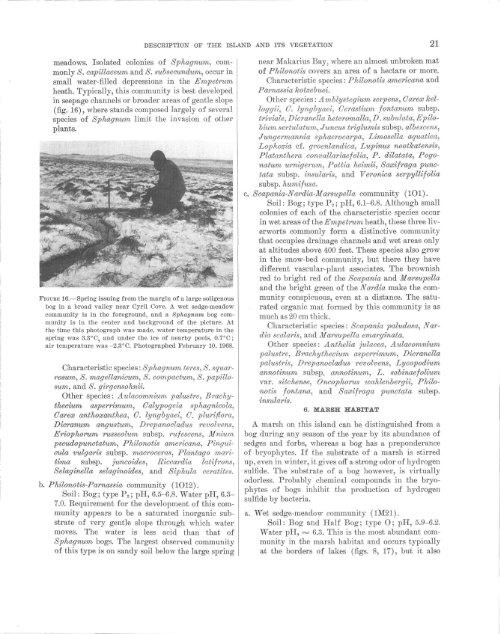Vegetation of Amchitka Island, Aleutian Islands, Alaska
Vegetation of Amchitka Island, Aleutian Islands, Alaska
Vegetation of Amchitka Island, Aleutian Islands, Alaska
Create successful ePaper yourself
Turn your PDF publications into a flip-book with our unique Google optimized e-Paper software.
DESCRIPTION OF THE ISLAND AND ITS VEGETATION 2 1<br />
meadows. Isolated colonies <strong>of</strong> Sphagnum, com-<br />
monly 8. capilZaceum and 8. subsecundt6m, occur in<br />
small water-filled depressions in the Enzpetmn~<br />
heath. Typically, this community is best developed<br />
in seepage channels or broader areas <strong>of</strong> gentle slope<br />
(fig. 16), where sbands composed largely <strong>of</strong> several<br />
species <strong>of</strong> Sphagnum limit the invasion <strong>of</strong> other<br />
plants.<br />
b. Philonotis-Parnassia community (1012).<br />
Soil : Bog; type P, ; pH, 6.5-6.8. Water pH, 6.3-<br />
7.0. Requirement for the development <strong>of</strong> this com-<br />
munity appears to be a saturated inorganic sub-<br />
strate <strong>of</strong> very gentle slope through which water<br />
moves. The water is less acid than that <strong>of</strong><br />
Sphagnum bogs. The largest observed community<br />
<strong>of</strong> this type is on sandy soil below the large spring<br />
near Mnkarius Ray, where an almost unbroken mat<br />
<strong>of</strong> Philonotis covers an area <strong>of</strong> a hectare or more.<br />
Characteristic species : Philonotis americana and<br />
Parnussia kotaebuei.<br />
Other species : Amblystegium serpens, Carex kel-<br />
loggii, C. Zyngbynei, Cerustium fontanum subsp.<br />
triviale, Dicranella heteromalla, D. subulata, Epilo-<br />
bium sertulatum, Juncus triglumis subsp. albescens,<br />
Jungermnnia sphaerocarpa, Limosella aquutica,<br />
Lophoaia cf. groenlundica, Lupinus nootkatemis,<br />
Platanthera convallariaefolia, P. dilatata, Pogo-<br />
natum urnigemm, Pottia heimii, Saxifraga pz~nc-<br />
tata subsp. insularis, and Veronica serpyllifolia<br />
subsp. humifusa.<br />
Scapania-Nardia-Marsupella community (101).<br />
Soil : Bog ; type P2 ; pH, 6.1-6.8. Although small<br />
colonies <strong>of</strong> each <strong>of</strong> the characteristic species occur<br />
in wet areas <strong>of</strong> the E7npetrum heath, these three liv-<br />
erworts commonly form a distinctive community<br />
that occupies drainage channels and wet areas only<br />
at altitudes above 400 feet. These species also gmw<br />
in the snow-bed community, but there they have<br />
different vascular-plant associates. The brownish<br />
red to bright red <strong>of</strong> the Scupalzia and Marsupella<br />
and the bright green <strong>of</strong> the Nardia make the corn-<br />
-- --<br />
/<br />
R~URF, 16.-Spring iss~uing from the margin <strong>of</strong> a large soligenous I munity conspicuous, even at a distance. The satubog<br />
in a broad valley near Cyril Cove. A wet sedgemeadow rated organic mat formed by this community is as<br />
community is in the foreground, and a Sphagnum bog community<br />
is in the center and background <strong>of</strong> the picture. At<br />
the time this photograph was made, water temperature in the<br />
spring was 3.3"C, and under the ice <strong>of</strong> nearby pooh, 0.7"C;<br />
air temperature was -2.3"C. Photographed February 10, 1968.<br />
much as 20 cm thick.<br />
Characteristic species : Scapania paludosa, Nardia<br />
scalaris, and JIarsupelZa emarginata.<br />
Other species: Anthelia juluaea, Aulacomnium<br />
palustre, Bra~h~thecium asperrirnum, Dicranella<br />
Characteristic species : Sphagnum teres, S. sguarrosum,<br />
8. magellan?~mrn, X. compactum, X. pupillosum,<br />
and S. girqensohnii.<br />
Other species: Aulacomnium palustre, Brachytheoium<br />
aspem'rnum, Calypogeia sphagnicola,<br />
Carex anthornantha, C. lyngbyaei, C. pluriflora,<br />
palustris, ~repnnocladus reuolvens, Lycopodium<br />
annotinurn subsp. annotinum, L. sa6inae f o Zium<br />
var. sitcheme, Oncophorz~s u~ahbnbergii, Phihnotis<br />
forttuna, and Smifraga punctata subsp.<br />
insular-is.<br />
6. MARSH EABITAT<br />
Dieranurn amgusturn, Drepanocladus revo7ven3, A marsh on this island can be distinguished from a<br />
Eriophorurn russeo7urn subsp. rufescens, d4nium bog during any season <strong>of</strong> the year by its abundance <strong>of</strong><br />
pseudopunctatum, Philonotis americana, Pingui- sedges and forbs, whereas a bog has a preponderance<br />
cula vulgaris subsp. macrocerus, Plantago ma&- <strong>of</strong> bryophytes. If the substrate <strong>of</strong> a marsh is stirred<br />
tima subsp. jumoides, Eiccardia Zatifrons, up, even in winter, it gives <strong>of</strong>f a strong odor <strong>of</strong> hydrogen<br />
Selagimlla selaginoides, and Siphula ceratites. sulfide. The substrate <strong>of</strong> a bog however, is virtually<br />
odorless. Probably chemical compounds in the bryophytes<br />
<strong>of</strong> bogs inhibit the production <strong>of</strong> hydrogen<br />
sulfide by bacteria.<br />
a. Wet sedge-meadow community (1M21).<br />
Soil: Bog and Half Bog; type 0 ; pH, 5.9-6.2.<br />
Water pH, - 6.3. This is the most abundant com-<br />
munity in the marsh habitat and occurs typically<br />
at the borders <strong>of</strong> lakes (figs. 8, 17), but it also
















